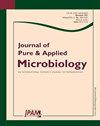Identification and Antimicrobial Susceptibility Patterns of Neisseria gonorrhoeae, Ureaplasma spp. and Mycoplasma spp. Isolated from Tribal Women
IF 0.7
Q4 MICROBIOLOGY
引用次数: 0
Abstract
Sexually transmitted infections (STIs) are a major public health problem worldwide with significant social and economic implications. Effective control and prevention strategies necessitate a thorough understanding of the prevalence, isolation, and identification of STI pathogens. The present study aims to provide a comprehensive analysis of the isolation, identification, prevalence, and antimicrobial susceptibility pattern of STI pathogens based on culture method analysis. Endocervical /vaginal swab samples from female patients symptomatic for STI were cultured on different selective and differential media and pathogens were identified by colony morphology and biochemical tests. Antimicrobial Susceptibility Test (AST) of isolated and identified culture pathogen was performed by using Kirby-Bauer disc diffusion method. Among 209 endocervical/vaginal swab samples from symptomatic patients, 126 (60.28%) tested positive and 83 (39.71%) negative. Ureaplasma spp. (n = 100) was the most prevalent isolate, constituting 79.36% of culture-positive samples, followed by N. gonorrhoea (n = 99) at 78.57%, and Mycoplasma spp. (n = 41) at 32.54% individually and in combination. AST analysis revealed erythromycin (74%), ofloxacin (69%), and roxithromycin (64%) as the most resistant antibiotics for Ureaplasma spp. N. gonorrhoea showed the highest resistance to cefixime (78.79%), followed by ofloxacin (75.76%) and erythromycin (69.7%). Azithromycin and erythromycin exhibited 100% resistance against Mycoplasma spp. The study provides information on the prevalent bacterial pathogens involved in STIs among women in Anuppur and Shahdol districts, Madhya Pradesh. Understanding the diversity, distribution patterns and antibiotic sensitivity of these pathogens is crucial for developing targeted interventions and effective prevention strategies in such resource-limited areas.从部落妇女中分离出的淋病奈瑟菌、解脲支原体和支原体的鉴定和抗菌药敏感性模式
性传播感染(STI)是全球主要的公共卫生问题,对社会和经济都有重大影响。要制定有效的控制和预防策略,就必须全面了解性传播感染病原体的流行、分离和鉴定情况。本研究旨在根据培养方法分析,全面分析性传播感染病原体的分离、鉴定、流行率和抗菌药敏感性模式。研究人员将有性传播感染症状的女性患者的宫颈内膜/阴道拭子样本在不同的选择性和鉴别培养基上进行培养,并通过菌落形态学和生化测试对病原体进行鉴定。采用柯比鲍尔盘扩散法对分离和鉴定出的培养病原体进行抗菌药敏感性试验(AST)。在 209 份有症状患者的宫颈内膜/阴道拭子样本中,126 份(60.28%)呈阳性,83 份(39.71%)呈阴性。解脲脲原体(n = 100)是最常见的分离株,占培养阳性样本的 79.36%,其次是淋球菌(n = 99),占 78.57%,支原体(n = 41)占 32.54%。淋球菌对头孢克肟的耐药性最高(78.79%),其次是氧氟沙星(75.76%)和红霉素(69.7%)。阿奇霉素和红霉素对支原体的耐药性为 100%。 该研究提供了有关中央邦阿努普尔和沙赫多尔地区妇女性传播感染中流行的细菌病原体的信息。了解这些病原体的多样性、分布模式和抗生素敏感性对于在这些资源有限的地区制定有针对性的干预措施和有效的预防策略至关重要。
本文章由计算机程序翻译,如有差异,请以英文原文为准。
求助全文
约1分钟内获得全文
求助全文
来源期刊

Journal of Pure and Applied Microbiology
BIOTECHNOLOGY & APPLIED MICROBIOLOGY-MICROBIOLOGY
CiteScore
2.00
自引率
0.00%
发文量
266
审稿时长
11 months
期刊介绍:
Journal of Pure and Applied Microbiology (JPAM) is a peer-reviewed, open access international journal of microbiology aims to advance and disseminate research among scientists, academics, clinicians and microbiologists around the world. JPAM publishes high-quality research in all aspects of microbiology in both online and print form on quarterly basis.
 求助内容:
求助内容: 应助结果提醒方式:
应助结果提醒方式:


